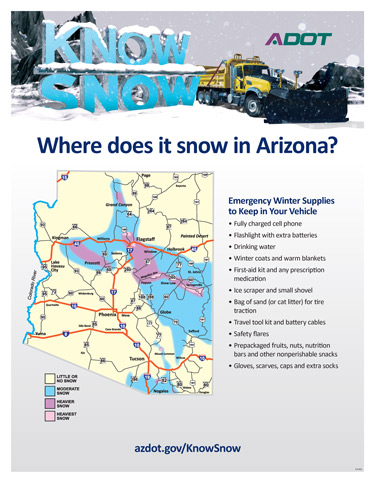Know Snow and Ice
Know Snow and Ice
Think it doesn't snow in Arizona? Think again!
Before You Travel
You and your vehicle must be prepared for driving in wintry conditions, including snow, ice and freezing temperatures.
- Plan your travel route in advance.
- Notify someone of your route, destination and projected arrival time.
- Fill your fuel tank and try to keep it at three-quarters full. Running out of gas — especially in a remote location — is extremely dangerous during winter conditions.
- Visit Arizona Traveler Information, download the AZ 511 app or dial 511 for updated road and weather conditions.
Preparing your Vehicle
Make sure your vehicle is in good working condition by paying special attention to the battery, ignition and exhaust systems, thermostat, defroster, heater and brakes. Take these precautions as well:
- Use snow tires, chains or studded tires as recommended, required or both on snowy, icy roads. Studded tires are permitted on Arizona highways from Oct. 1 to May 1.
- Make sure the antifreeze in your radiator can handle freezing temperatures.
- Install new windshield wiper blades and solvent.
- Ensure your headlights, taillights, brake lights and turn signals work well and can be seen if visibility is low.
- Change your motor oil to a winter grade.
"Must-Haves" for Every Vehicle
Never drive into snowy, icy or cold conditions without a fully-charged cell phone, drinking water and winter coats, warm blankets or both. Consider keeping these items available too:
- Gloves, scarves, caps and extra socks
- Necessary prescribed medication(s) and pain relievers
- A first-aid kit
- A flashlight with extra batteries
- An ice scraper
- A small bag of sand (or kitty litter) for wheel traction
- A small folding shovel for snow removal
- A travel tool kit and battery cables
- Safety flares
- Plastic bags or containers for sanitation
- Healthy snacks
- A road map
Driving on Wet or Slippery Roadways
Drive for conditions: slower speed, slower acceleration.
Crashes or Other Situations Requiring Emergency Assistance
- Dial 911.
- If possible, move the vehicle out the travel lanes into a safe area.
- Attend to all medical needs in a safe place if possible; also, find a safe place to call for roadside assistance.
- If your vehicle becomes nonoperational, raise the front hood and activate its flashing hazard lights to signal to other drivers and emergency responders that it is disabled
Stalled or Stopped Vehicles
If possible, do not stop in or near travel lanes. Stop in a safe area where the vehicle can be serviced or removed. Do not stay in or close to a disabled vehicle.
Respect the Plow!
- Never pass a snowplow! Slow down and be patient.
- Stay at least four car lengths behind snowplows and equipment. Plowed snow can create a cloud that reduces visibility, and spreaders on trucks throw salt or sand that can damage your vehicle.
- Watch for snowplows operating in multiple travel lanes or in tandem.
- If approaching an oncoming snowplow, slow down and give the plow extra room.


